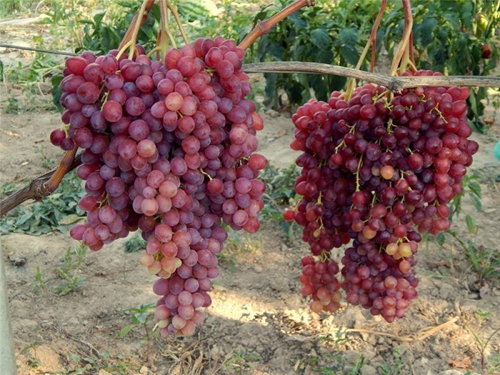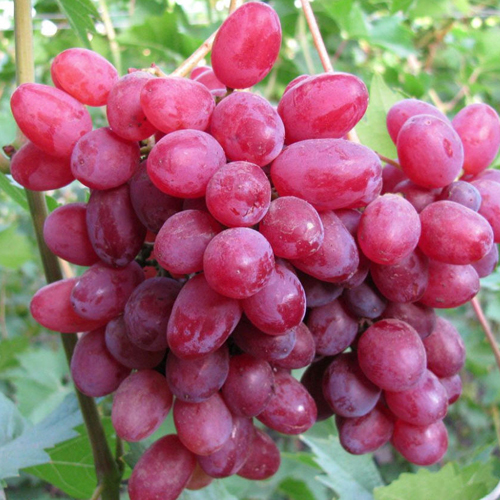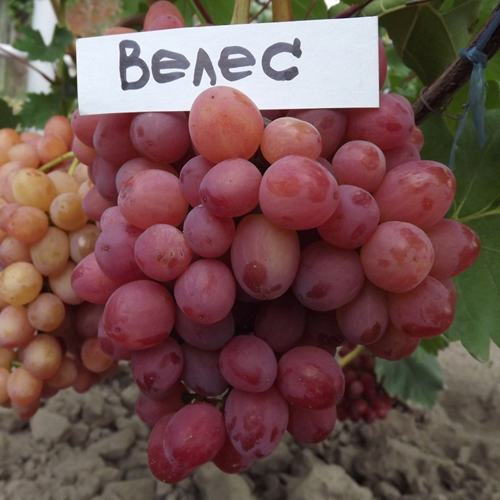Veles grape variety
The grape with the divine name Veles is one of the most wonderful dessert hybrids, born by the hands of the famous national breeder from Zaporozhye V.V. Zagorulko. This variety appeared relatively recently, but immediately after its presentation it was awarded two gold medals at the international competition in Crimea "Golden Bunch of Grapes" in the nominations "Professional Tasting Commission" and "People's Tasting Commission". And these awards turned out to be well deserved. Large, attractive-looking bunches with excellent taste and nutmeg aroma of seedless berries leave no one indifferent.

To obtain this hybrid form, Vitaly Vladimirovich crossed the seedless Rusbol of the selection of the Novocherkassk NIIViV them. ME AND. Potapenko with his own hybrid Sophia, whose paternal form was also a seedless variety - Kishmish Radiant... As a result, the author managed to achieve the transfer of this valuable trait to the resulting hybrid. By the way, Vitaly Zagorulko already has eight raisins in his assets, but he considers Veles to be the best. And not in vain. This hybrid form, despite the average indicators of resistance to frost and pests, will give odds to many traditional seedless grape varieties in terms of the degree of unpretentiousness and adaptability to growing in conditions that differ from ideal.
At the moment, the hybrid is not included in the State Register of approved varieties, however, thanks to the recognition by amateur winegrowers, it is rapidly expanding the geography of its distribution. Fortunately, he has all the prerequisites for this, from the lack of seeds, which is attractive to many, and ending with the very early ripening of fruits, which makes it possible to cultivate it far beyond the traditional wine-growing regions.
Agrobiological characteristics
Veles bushes of high vigor. Crowns of young shoots are green with a brownish-bronze tint. Leaves are large, rounded, or slightly stretched in width, usually three-lobed, reticulate-wrinkled, medium dissected. The lateral notches are deep, open, lyre-shaped with a rounded bottom; the petiole is open, vaulted, narrow, with a sharp bottom. The denticles along the edge of the leaf blade are dome-shaped, low and wide. The flowers of the grapes are bisexual, have a satisfactory ability to fertilize with their own pollen, however, in the case of additional manual pollination, a significant increase in yield is noted. The variety does not have a tendency to pea.

The bunches are very large - about 20 cm long, with a maximum weight of up to three kilograms, but on average 800-1500 grams. They are conical, sometimes winged, of medium density or loose. Thanks to a brush that is not too knocked down, the berries are not deformed. The comb is of medium length, the stems of the berries are long, light green in color, strong. The berries are relatively large, oval, weighing up to 6-7 grams. The color is golden-pink, but may differ in intensity depending on the degree of illumination of the bunches during ripening. The pulp of Veles is quite dense, very tender and juicy, with a pleasant taste with a harmonious ratio of sugar and acid and a distinct nutmeg aftertaste. The skin is very thin, it is not felt at all during use, it is covered with a weak layer of wax bloom. The seeds in the berry are presented in the form of microscopic rudiments, when consumed, they are not felt at all, which significantly increases the tasting ratings of fresh grapes. The berries that are loosely arranged in bunches are well ventilated and do not rot, however, excessively humid weather can lead to their cracking. Wasps, despite their thin skin, are rarely damaged. Bunch rolls also usually do not annoy the variety.
The crop is used for fresh consumption, but due to its seedlessness, it can be widely used in cooking, confectionery, and drying for raisins. On the market, Veles enjoys great interest from buyers due to its attractive color, large size of bunches and berries, and the absence of seeds, which favorably distinguishes it among its counterparts on the counter. A carefully harvested crop retains high marketability for a long time and is suitable for long-distance transportation.

In terms of ripening, the variety belongs to the super-early group, which means that the grapes are ready for harvesting within 95-105 days after bud break. To achieve optimal conditions, it only needs 2100 ° C active temperatures in total, which makes it possible to cultivate it in fairly northern regions, and in the south it even manages to give a second small crop on stepchildren. On average, Veles' yield is very decent and stable - 10-15 kilograms from an adult, well-formed bush with a significant supply of perennial wood. For compact covering bushes, this figure may be lower. The hybrid exhibits an average frost resistance (-21 ° C), which, nevertheless, is much better than the indicators of Central Asian raisins. Before winter, the shoots have time to ripen very well along the entire length. The variety has a potentially high yield and is prone to crop overload. On each fruitful shoot, 2-3 inflorescences can be laid. The sugar content of the juice of berries at the time of ripening is 16.5-19.0 g / 100 ml, the acidity is 6-7 g / l.
Agrotechnical features
Despite the fact that Veles has rather high indicators of resistance to unfavorable natural factors in relation to traditional seedless forms of grapes, its cultivation is still associated with a number of features that must be paid close attention to. This is not a variety that you can say "planted and forgot".
First of all, it is necessary to determine the existing climatic conditions, and based on the data on the minimum winter temperatures, choose a scheme for maintaining a bush. Almost everywhere, with the exception of regions with very mild winters, Veles is grown in covering or semi-covering crops. Covering options can be both fan formations and various options for squat, usually inclined, cordons. It is convenient to remove such forms from the trellis in autumn and provide them with a heat-insulating shelter. In semi-covering methods of bush management, its main part is formed on an uncovered trunk, and the reserve lightweight part receives protection from frost in winter. This is done so that in the event of the death of the main part, it would be possible to quickly restore the bush from the remaining reserve. This option is appropriate only in regions where temperatures critical for grapes below -21 ° C are very rare. If such frosts are not uncommon in your region, you definitely need to choose completely covering forms.
The second point to which you need to pay attention is to ensure the protection of the vineyard from diseases. The average resistance to them of 3.5-4 points, which this hybrid of grapes possesses, means that the number of fungicidal treatments can be reduced compared to standard schemes for susceptible varieties, but it will not be possible to completely abandon them. To protect Veles, use only approved drugs, strictly following the instructions and keeping the waiting time. Don't forget about prevention. The reproduction rate, and hence the harmfulness of fungi, can be significantly reduced by such simple agricultural techniques as timely breaking, pinching, tying shoots and lightening bunches for better ventilation of the bushes, as well as removing weeds and maintaining the soil in a loose and clean state.At the same time, it is not worth overdoing it with the removal of leaves around the brushes on this particular variety, since the attractive rich pink color of the peel does not appear under the influence of direct sunlight. Also, do not overexpose the grapes on the bushes, in the event of a sharp change in soil moisture or the onset of damp weather, there is a high probability of damage to the crop due to cracking of the berries.
Additional attention must be paid to Veles during flowering. As already mentioned, a small additional pollination effort results in an increase in yield by 20-25%. And if you add to this the treatment with a special stimulant Gibberellin at the time recommended for seedless varieties and precisely adjusted concentrations, you can also significantly improve the quality of the crop, having achieved the absence of even traces of seeds in the berries.
And finally, we must not forget about the rationing of grape bushes with a harvest. During spring pruning, do not leave more than 35-40 eyes on the plant. The pruning itself should be carried out at an average length - 6-8 buds. During the period of green operations, mercilessly break out the sterile and weak shoots, and leave no more than one brush on the fruitful ones.
If you do not overload the plants and ensure their competent protection, there is no doubt that Veles will give the grower an excellent harvest in taste, aroma and appearance, and will also have time to prepare well for winter, so that next season he will be ready for abundant fruiting.








